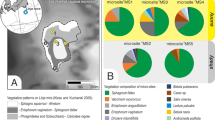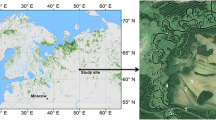Abstract
Ombrotrophic bogs can comprise a mosaic of vegetation patches and open-water pools, with hydrological and biogeochemical connections between pools and the surrounding peat and vegetation. To establish these connections, we studied the spatial heterogeneity of hydrology and water chemistry in two zones of distinct vegetation assemblages in the subboreal Grande plée Bleue peatland, southern Québec, Canada. We show that seasonal water-level fluctuations are greater and organic C, N and P concentrations are higher in the peat pore water of a forested zone than in a neighboring open-bog zone; that vegetation is responsible for 69% of the spatial variations in hydrology and water chemistry. Vegetation also explains 31% of the temporal variation in water chemistry, with higher increases in C, N and P concentrations over the growing season in the forested peat and pools than in the open-bog zone. We also show that C, N and P concentrations and water-level fluctuations in pools, especially during precipitation events, were lower than in the surrounding peat. Our results suggest the existence of small “watersheds” to the pools with water flowing in during wet and out during dry periods. Localized patterns emerge from the vegetation–hydrology–water chemistry interactions, with pools influencing the persistence of trees in the central part of an ombrotrophic bog.







Similar content being viewed by others
References
Arsenault J, Talbot J, Moore TR. 2018. Environmental controls of C, N and P biogeochemistry in peatland pools. Sci Total Environ 631–632:714–22.
Belyea LR, Lancaster J. 2002. Inferring landscape dynamics of bog pools from scaling relationships and spatial patterns. J Ecol 90:223–34.
Breeuwer A, Robroek BJM, Limpens J, Heijmans MMPD, Schouten MGC, Berendse F. 2009. Decreased summer water table depth affects peatland vegetation. Basic Appl Ecol 10:330–9.
Brown SM, Petrone RM, Mendoza C, Devito KJ. 2010. Surface vegetation controls on evapotranspiration from a sub-humid Western Boreal Plain wetland. Hydrol Process 24:1072–85.
Bubier JL. 1991. Patterns of Picea mariana (black spruce) growth and raised bog development in Victory Basin, Vermont. Bull Torrey Bot Club 118:399–411.
Carlyle JC, Malcolm DC. 1986. Nitrogen availability beneath pure spruce and mixed larch + spruce stands growing on a deep peat—I. Net N mineralization measured by field and laboratory incubations. Plant Soil 93:95–113.
Conrad O, Bechtel B, Bock M, Dietrich H, Fischer E, Gerlitz L, Wehberg J, Wichmann V, Böhner J. 2015. System for Automated Geoscientific Analyses (SAGA) v. 2.1.4. Geosci Model Dev 8:1991–2007.
Dalva M, Moore TR. 1991. Sources and sinks of dissolved organic carbon in a forested swamp catchment. Biogeochemistry 15:1–19.
Damman AWH. 1986. Hydrology, development, and biogeochemistry of ombrogenous peat bogs with special reference to nutrient relocation in a western Newfoundland bog. Can J Bot 64:384–94.
Dubé S, Plamondon AP, Rothwell RL. 1995. Watering up after clear-cutting on forested wetlands of the St. Lawrence lowland. Water Resour Res 31:1741–50.
Ebina J, Tsutsui T, Shirai T. 1983. Simultaneous determination of total nitrogen and total phosphorus in water using peroxodisulfate oxidation. Water Res 17:1721–6.
Environment Canada. 2018. Canadian climate normals 1981–2010 Station Data, Lauzon. http://climate.weather.gc.ca/climate_normals/results_1981_2010_e.html?stnID=5393&autofwd=1. Last accessed 20/08/2018.
Fenner N, Ostle N, Freeman C, Sleep D, Reynolds B. 2004. Peatland carbon efflux partitioning reveals that Sphagnum photosynthate contributes to the DOC pool. Plant Soil 259:345–54.
Fraser CJD, Roulet NT, Lafleur M. 2001. Groundwater flow patterns in a large peatland. J Hydrol 246:142–54.
Hamilton JD, Kelly CA, Rudd JWM, Hesslein H, Roulet NT. 1994. Flux to the atmosphere of CH4 and CO2 from wetland ponds on the Hudson Bay lowlands (HBLs). J Geophys Res Atmos 99:1495–510.
Holden J, Moody CS, Edward Turner T, McKenzie R, Baird AJ, Billett MF, Chapman PJ, Dinsmore KJ, Grayson RP, Andersen R, Gee C, Dooling G. 2018. Water-level dynamics in natural and artificial pools in blanket peatlands. Hydrol Process 32:550–61.
Kaštovská E, Straková P, Edwards K, Urbanová Z, Bárta J, Mastný J, Šantrůčková H, Picek T. 2018. Cotton-grass and blueberry have opposite effect on peat characteristics and nutrient transformation in peatland. Ecosystems 21:443–58.
Laiho R, Vasander H, Penttilä T, Laine J. 2003. Dynamics of plant-mediated organic matter and nutrient cycling following water-level drawdown in boreal peatlands. Global Biogeochem Cycles. https://doi.org/10.1029/2002GB002015.
Laine J, Vasander H, Laiho R. 1995. Long-term effects of water level drawdown on the vegetation of drained pine mires in southern Finland. J Appl Ecol 32:785–802.
Larmola T, Leppänen SM, Tuittila E-S, Aarva M, Merilä P, Fritze H, Tiirola M. 2014. Methanotrophy induces nitrogen fixation during peatland development. Proc Natl Acad Sci 111:734–9.
Lavoie M, Colpron-Tremblay J, Robert ÉC. 2012. Développement d’une vaste tourbière ombrotrophe non perturbée en contexte périurbain au Québec méridional. Ecoscience 19:285–97.
Lee S, Wolberg G, Shin SY. 1997. Scattered data interpolation with multilevel b-splines. IEEE Trans Vis Comput Graph 3:228–44.
Legendre P, Legendre L. 2012. Numerical ecology. 3rd edn. London: Elsevier.
Loisel J, Yu Z. 2013. Surface vegetation patterning controls carbon accumulation in peatlands. Geophys Res Lett 40:5508–13.
Loisel J, Yu Z, Beilman DW, Camill P, Alm J, Amesbury MJ, Anderson D, Andersson S, Bochicchio C, Barber K, Belyea LR, Bunbury J, Chambers FM, Charman DJ, De Vleeschouwer F, Fialkiewicz-Koziel B, Finkelstein SA, Galka M, Garneau M, Hammarlund D, Hinchcliffe W, Holmquist J, Hughes P, Jones MC, Klein ES, Kokfelt U, Korhola A, Kuhry P, Lamarre A, Lamentowicz M, Large D, Lavoie M, MacDonald G, Magnan G, Makila M, Mallon G, Mathijssen P, Mauquoy D, McCarroll J, Moore TR, Nichols J, O’Reilly B, Oksanen P, Packalen M, Peteet D, Richard PJH, Robinson S, Ronkainen T, Rundgren M, Sannel ABK, Tarnocai C, Thom T, Tuittila E-S, Turetsky M, Valiranta M, van der Linden M, van Geel B, van Bellen S, Vitt D, Zhao Y, Zhou W. 2014. A database and synthesis of northern peatland soil properties and Holocene carbon and nitrogen accumulation. Holocene 24:1028–42.
Malmer N. 1986. Vegetational gradients in relation to environmental conditions in north western European Mires. Can J Bot 64:375–83.
Mastný J, Kaštovská E, Bárta J, Chroňáková A, Borovec J, Šantrůčková H, Urbanová Z, Edwards RK, Picek T. 2018. Quality of DOC produced during litter decomposition of peatland plant dominants. Soil Biol Biochem 121:221–30.
Moore TR, Blodau C, Turunen J, Roulet NT, Richard PJH. 2005. Patterns of nitrogen and sulfur accumulation and retention in ombrotrophic bogs, eastern Canada. Glob Change Biol 11:356–67.
Murphy M, Laiho R, Moore TR. 2009. Effects of water table drawdown on root production and aboveground biomass in a boreal bog. Ecosystems 12:1268–82.
Oksanen J, Blanchet FG, Kindt R, Legendre P, Minchin PR, O’Hara RB, Simpson GL, Solymos P, Stevens MHH, Wagner H. 2018. Vegan: community ecology package. R package ver 2-5-1. https://cran.r-project.org/package=vegan.
Pelletier L, Strachan IB, Garneau M, Roulet NT. 2014. Carbon release from boreal peatland open water pools: implication for the contemporary C exchange. J Geophys Res Biogeosci 119:207–22.
Pinsonneault AJ, Moore TR, Roulet NT, Lapierre JF. 2016. Biodegradability of vegetation-derived dissolved organic carbon in a cool temperate ombrotrophic bog. Ecosystems 19:1023–36.
R Core Team. 2018. R: A language and environment for statistical computing. https://www.r-project.org/.
Read DJ, Leake JR, Perez-Moreno J. 2004. Mycorrhizal fungi as drivers of ecosystem processes in heathland and boreal forest biomes. Can J Bot 82:1243–63.
Rezanezhad F, Price JS, Quinton WL, Lennartz B, Milojevic T, Van Cappellen P. 2016. Structure of peat soils and implications for water storage, flow and solute transport: a review update for geochemists. Chem Geol 429:75–84.
Sarkkola S, Hökkä H, Koivusalo H, Nieminen M, Ahti E, Päivänen J, Laine J. 2010. Role of tree stand evapotranspiration in maintaining satisfactory drainage conditions in drained peatlands. Can J For Res 40:1485–96.
Siegel DI, Glaser PH, So J, Janecky DR. 2006. The dynamic balance between organic acids and circumneutral groundwater in a large boreal peat basin. J Hydrol 320:421–31.
Talbot J, Richard PJH, Roulet NT, Booth RK. 2010. Assessing long-term hydrological and ecological responses to drainage in a raised bog using paleoecology and a hydrosequence. J Veg Sci 21:143–56.
Van den Brink PJ, Ter Braak CJF. 1999. Principal response curves: analysis of time-dependent multivariate responses of biological community to stress. Environ Toxicol Chem 18:138–48.
Verhoeven JTA, Maltby E, Schmitz MB. 1990. Nitrogen and phosphorus mineralization in fens and bogs. J Ecol 78:713–26.
Vitt DH, Chee WL. 1990. The relationships of vegetation to surface water chemistry and peat chemistry in fens of Alberta, Canada. Vegetatio 89:87–106.
Waiser MJ, Robarts RD. 2004. Photodegradation of DOC in a shallow prairie wetland: evidence from seasonal changes in DOC optical properties and chemical characteristics. Biogeochemistry 69:263–84.
Wang M, Moore TR. 2014. Carbon, nitrogen, phosphorus, and potassium stoichiometry in an ombrotrophic peatland reflects plant functional type. Ecosystems 17:673–84.
Wang M, Moore TR, Talbot J, Riley JL. 2015. The stoichiometry of carbon and nutrients in peat formation. Glob Biogeochem Cycl 29:113–21.
Weishaar JL, Aiken G, Bergamaschi B, Fram M, Fujii R, Mopper K. 2003. Evaluation of specific ultra-violet absorbance as an indicator of the chemical content of dissolved organic carbon. Environ Sci Technol 37:4702–8.
Wheeler BD, Proctor MCF. 2000. Ecological gradients, subdivisions and terminology of north-west European mires. J Ecol 88:187–203.
Wickham H. 2009. ggplot2—elegant graphics for data analysis. New York: Springer.
Wickland KP, Neff JC, Aiken GR. 2007. Dissolved organic carbon in Alaskan boreal forest: sources, chemical characteristics, and biodegradability. Ecosystems 10:1323–40.
Xu J, Morris PJ, Liu J, Holden J. 2018. PEATMAP: refining estimates of global peatland distribution based on a meta-analysis. Catena 160:134–40.
Zivkovic T, Disney K, Moore TR. 2017. Variations in nitrogen, phosphorus, and δ15 N in Sphagnum mosses along a climatic and atmospheric deposition gradient in eastern Canada. Botany 95:829–39.
Acknowledgments
We would like to thank Jules Regard, Zeinab Khanafer, Jordan Paillard, Andy Hennebelle, Evrard Kouadio, Philippe Major, Mike Dalva and Hélène Lalande for their help in the field and in laboratory analysis. We also thank the Société de gestion et de mise en valeur de la Grande plée Bleue for granting access to the study site. The research was funded through a Fonds de recherche du Québec—Nature et Technologies (FRQNT) grant to JT.
Author information
Authors and Affiliations
Corresponding author
Additional information
Author Contributions
JA designed the study, performed the research, analyzed the data and wrote the paper. JT and TRM designed the study and wrote the paper. MPB performed the research and wrote the paper. JF contributed new methods and wrote the paper. NTR designed the study.
Electronic supplementary material
Below is the link to the electronic supplementary material.
Rights and permissions
About this article
Cite this article
Arsenault, J., Talbot, J., Moore, T.R. et al. The Spatial Heterogeneity of Vegetation, Hydrology and Water Chemistry in a Peatland with Open-Water Pools. Ecosystems 22, 1352–1367 (2019). https://doi.org/10.1007/s10021-019-00342-4
Received:
Accepted:
Published:
Issue Date:
DOI: https://doi.org/10.1007/s10021-019-00342-4




